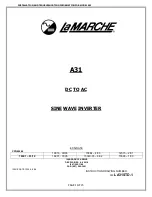
Goodrive10 Series Mini VFD
Communication protocol
-88-
the communication bus. After receiving the first domain (address information), each network
device identifies the byte. After the last byte is transmitted, a similar transmission interval
(the transmission time of 3.5 bytes) is used to indicate that the transmission of the frame
ends. Then, the transmission of a new frame starts.
Start, preceded by
a time gap with a
minimum length of
3.5 characters
Slave
address
Function
code
Data
CRC
End, followed by a
time gap with a
minimum length of
3.5 characters
RTU data frame format
Modbus packet
The information of a frame must be transmitted in a continuous data flow. If there is an
interval greater than the transmission time of 1.5 bytes before the transmission of the entire
frame is complete, the receiving device deletes the incomplete information, and mistakes
the subsequent byte for the address domain of a new frame. Similarly, if the transmission
interval between two frames is shorter than the transmission time of 3.5 bytes, the receiving
device mistakes it for the data of the last frame. The CRC check value is incorrect due to the
disorder of the frames, and thus a communication fault occurs.
The following table describes the standard structure of an RTU frame.
START (frame header) T1-T2-T3-T4 (time gap with a min. length of 3.5 bytes)
ADDR (slave address
domain)
Communication address: 0
–247 (in decimal system) (0 indicates
the broadcast address)
CMD (function domain)
03H:read slave parameters
06H:write slave parameters
Data domain
DATA (N-1)
…
DATA (0)
TData of 2*N bytes, main content of the communication as well as
the core of data exchanging
LSB of CRC CHK
Detection value:CRC (16 bits)
MSB of CRC CHK
END (frame tail)
T1-T2-T3-T4 (time gap with a min. length of 3.5 bytes)
7.2.2.2 RTU communication frame error check modes
During the transmission of data, errors may occur due to various factors (such as
electromagnetic interference). For example, if the sending message is a logic "1", A-B
potential difference on RS485 should be 6V, but in reality, it may be -6V because of
electromagnetic interference, and then the other devices take the sent message as logic "0".
Without error check, the data receiving device cannot identify data errors and may make a
wrong response. The wrong response may cause severe problems. Therefore, the data
must be checked.
Summary of Contents for GD10-0R2G-2-B
Page 1: ......
Page 125: ...66001 00099...
















































